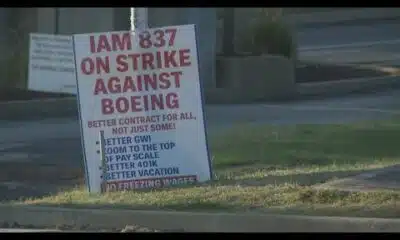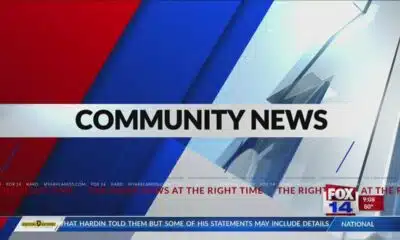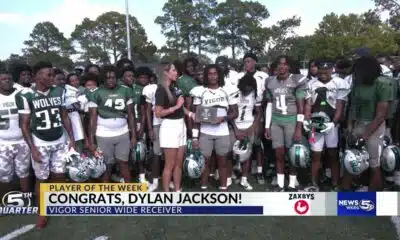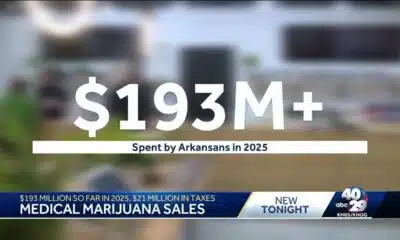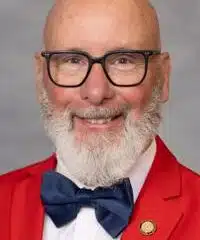News from the South - Louisiana News Feed
Facial recognition in policing is getting state-by-state guardrails • Louisiana Illuminator
Facial recognition in policing is getting state-by-state guardrails
by Paige Gross, Louisiana Illuminator
February 2, 2025
In January 2020, Farmington Hills, Michigan resident Robert Williams spent 30 hours in police custody after an algorithm listed him as a potential match for a suspect in a robbery committed a year and a half earlier.
The city’s police department had sent images from the security footage at the Detroit watch store to Michigan State Police to run through its facial recognition technology. An expired driver’s license photo of Williams in the state police database was a possible match, the technology said.
But Williams wasn’t anywhere near the store on the day of the robbery.
Williams’ case, now a settled lawsuit which was filed in 2021 by the American Civil Liberties Union and Michigan Law School’s Civil Rights Litigation Initiative, was the first public case of wrongful arrest due to misuse of facial recognition technology (FRT) in policing.
But the case does not stand alone. Several more documented cases of false arrests due to FRT have come out of Detroit in the years following Williams’ arrest, and across the country, at least seven people have been falsely arrested after police found a potential match in the depths of FRT databases.
Williams’ lawsuit was the catalyst to changing the way the Detroit Police Department may use the technology, and other wrongful arrest suits and cases are being cited in proposed legislation surrounding the technology. Though it can be hard to legislate technology that gains popularity quickly, privacy advocates say unfettered use is a danger to everyone.
“When police rely on it, rely on them, people’s lives can be turned upside down,” said Nate Wessler, one of the deputy directors of the Speech, Privacy and Technology Project at the national ACLU.
How are police using FRT?
Facial recognition technology has become pervasive in Americans’ lives, and can be used for small, personal tasks like unlocking a phone, or in larger endeavors, like moving thousands of people through airport security checks.
The technology is built to assess a photo, often called a probe image, against a database of public photos. It uses biometric data like eye scans, facial geometry, or distance between features to assess potential matches. FRT software converts the data into a unique string of numbers, called a faceprint, and will present a set of ranked potential matches from its database of images.
When police use these systems, they are often uploading images from a security camera or body-worn camera. Popular AI company Clearview, which often contracts with police and has developed a version specifically for investigations, says it hosts more than 50 billion facial images from public websites, including social media, mugshots and driver’s license photos.
Katie Kinsey, chief of staff and tech policy counsel for the Policing Project, an organization focused on police accountability, said that she’s almost certain that if you’re an adult in the U.S., your photo is included in Clearview’s database, and is scanned when police are looking for FRT matches.
“You’d have to have no presence on the internet to not be in that database,” she said.
Judge blocks enforcement of Louisiana’s 25-foot buffer zone for police
The use of FRT by federal law enforcement agencies goes back as long as the technology has been around, more than two decades, Kinsey said, but local police departments increased their use in the last 10 years.
Usually, police are using it in the aftermath of a crime, but civil liberties and privacy concerns are heightened with the idea that the technology could be used to scan faces in real time, with geolocation data attached, she said. Kinsey, who often meets with law enforcement officers to develop best practices and legislative suggestions, said she believes police forces are wary of real-time uses.
Boston Police attempted to use it while searching for the suspects in the 2013 Boston Marathon bombing, for example, but grainy imaging hindered the technology in identifying the culprits, Kinsey said.
GET THE MORNING HEADLINES.
Wrongful arrests
FRT’s role in wrongful arrest cases usually come from instances where police have no leads on a crime other than an image captured by security cameras, said Margaret Kovera, a professor of psychology at the John Jay College of Criminal Justice and an eyewitness identification expert.
Before the technology was available, police needed investigative leads to pin down suspects — physical evidence, like a fingerprint, or an eyewitness statement, perhaps. But with access to security cameras and facial recognition technology, police can quickly conjure up several possible suspects that have a high likelihood of a match.
With millions of faces in a database, the pool of potential suspects feels endless. Because the technology finds matches that look so similar to the photo provided, someone choosing a suspect in a photo array can easily make a wrong identification, Kovera said. Without further investigation and traditional police work to connect the match chosen by the technology to a crime scene, the match is useless.
“You’re going to up the number of innocent people who are appearing as suspects and you’re going to decrease the number of guilty people,” Kovera said. “And just that act alone is going to mess up the ratio of positive identifications in terms of how many of them are correct and how many of them are mistaken.”
Jeff Landry is traveling in a $5.5 million plane Louisiana State Police recently purchased
In the seven known cases of wrongful arrest following FRT matches, police failed to conduct sufficient followup investigation, which could have prevented the incidents. One man in Louisiana spent a week in jail, despite being 40 pounds lighter than a thief allegedly seen in surveillance footage. A woman who was eight months pregnant in Detroit was held in custody for 11 hours after being wrongfully arrested for carjacking, despite no mention of the carjacker appearing pregnant.
When Williams was arrested in January 2020, he was the ninth-best match for the person in the security footage, Michael King, a research scientist with the Florida Institute of Technology’s (FIT) Harris Institute for Assured Information, testified in the ACLU’s lawsuit. And detectives didn’t pursue investigation of his whereabouts before making the arrest.
Detroit police used the expired license image in a photo array presented to a loss-prevention contractor who wasn’t present at the scene of the crime. The loss prevention contractor picked Williams as the best match to the security cameras. Without further investigation of Williams’ whereabouts in October 2018, Detroit Police arrested him and kept him in custody for 30 hours.
The lawsuit says Williams was only informed after several lines of questioning that he was there because of a match via facial recognition technology. As part of the settlement, which Williams reached in the summer of 2024, Detroit Police had to change the way it uses facial recognition technology. The city now observes some of the strictest uses of the technology across the country, which is legislated on a state-by-state basis.
Police can no longer go straight from facial recognition technology results to a witness identification procedure, and they cannot apply for an arrest warrant based solely on the results of a facial recognition technology database, Wessler said. Because there can be errors or biases in the technology, and by its users, guardrails are important to protect against false arrests, he said.
Emerging laws
At the start of 2025, 15 states — Washington, Oregon, Montana, Utah, Colorado, Minnesota, Illinois, Alabama, Virginia, Maryland, New Jersey, Massachusetts, New Hampshire, Vermont and Maine — had some legislation around facial recognition in policing. Some states, like Montana and Utah, require a warrant for police to use facial recognition, while others, like New Jersey, say that defendants must be notified of its use in investigations.
At least seven more states are considering laws to clarify how and when the technology can be used — lawmakers in Georgia, Hawaii, Kentucky, Massachusetts, Minnesota, New Hampshire and West Virginia have introduced legislation.
Like all AI technologies, facial recognition can have baked-in bias, or produced flawed responses. FRT has historically performed worse on groups of Black faces than on white, and has shown gender differences, too. AI is trained to get better over time, but people seem to think that simply by involving humans in the process, we’ll catch all the problems, Wessler said.
But humans actually tend to have something called “automation bias,” Wessler said — “this hardwired tendency of people to believe a computer output’s right as many times as you tell somebody the algorithm might get it wrong.”
So when police are relying on facial recognition technology as their primary investigative tool, instead of following older law enforcement practices, it’s “particularly insidious” when it goes wrong, Wessler said.
“I often say that this is a technology that is both dangerous when it works and dangerous when it doesn’t work,” Wessler said.
Kinsey said in her work with the Policing Project, she’s found bipartisan support for placing guardrails on police using this technology. Over multiple meetings with privacy advocates, police forces, lawmakers and academics, the Policing Project developed a legislative checklist.
It outlines how police departments could use the technology with transparency, testing and standards strategies, officer training, procedural limits and disclosure to those accused of crimes. It also says legislation should require vendors to disclose documentation about their FRT systems, and that legislation should provide ways to address violations of their use.
The Policing Project also makes similar recommendations for congressional consideration, and while Kinsey said she does believe federal guidelines are important, we may not see federal legislation passed any time soon. In the meantime, we’ll likely continue to see states influencing each other, and recent laws in Maryland and Virginia are an example of a broad approach to regulating FRT across different areas.
Kinsey said that in her meetings with police, they assert that the technologies are essential to crime solving. She said she believes there is space for FRT, and other technologies used by police like license plate readers and security cameras, but that doing so unfettered can do a lot of harm.
“We think some of them can absolutely provide benefits for solving crime, protecting victims,” Kinsey said. “But using those tools, using them according to rules that are public, transparent and have accountability, are not mutually exclusive goals. They can actually happen in concert.”
YOU MAKE OUR WORK POSSIBLE.
Louisiana Illuminator is part of States Newsroom, a nonprofit news network supported by grants and a coalition of donors as a 501c(3) public charity. Louisiana Illuminator maintains editorial independence. Contact Editor Greg LaRose for questions: info@lailluminator.com.
News from the South - Louisiana News Feed
OPPJ Comprehensive Plan
SUMMARY: The Ouachita Parish Police Jury is conducting a series of community meetings to gather public input for their comprehensive plan guiding future growth. Police Jury members, including Larry Bratton from District D, emphasize the importance of reflecting residents’ voices in the master plan. Community members participated in interactive stations, allocating resources to priorities like infrastructure and downtown development, to help shape goals for the next 2, 5, and 20 years. Landscape architect Matt Pizatella and partners from Atlas support the effort. Bratton stresses that without proactive planning, the parish risks costly and less beneficial outcomes in the long term.
OPPJ Comprehensive Plan
News from the South - Louisiana News Feed
Drowned child recovers thanks to oxygen chamber, but insurance did not approve
SUMMARY: In 2018, Will Boyton’s 3-year-old son, Robert, drowned and was without oxygen for nearly an hour. Despite hospitals urging them to give up hope, Will insisted on hyperbaric oxygen chamber treatment, inspired by its success in brain injury cases. Robert began treatments at Harch Hyperbarics, showing rapid improvement: from unresponsive and bent backward to recognizing family and laughing within days. Over years, combined with stem cell therapy, Robert vastly surpassed his initial brain-dead prognosis. Though studies and treatments show promise in severe brain injuries, insurance refuses to reimburse these costly treatments, as the FDA hasn’t approved them.
For years, Medical Watch has covered adults and children with brain injuries, coming to New Orleans from around the world, for a treatment considered controversial.
News from the South - Louisiana News Feed
Wagers on touchdowns, strikeouts and even penalties: States eye limits on prop bets
by Kevin Hardy, Louisiana Illuminator
September 9, 2025
As a bankruptcy attorney, New Jersey Assemblymember Dan Hutchison said he sees clients “all the time” whose betting on football and baseball quickly leads to missed car payments, delinquent mortgages and, ultimately, bankruptcy.
The rise of live, in-game bets — in which a gambler could place more than 200 individual bets during a baseball game if they wager on each pitch thrown — has only amplified his misgivings.
“And I’m like, are you kidding me? I mean, they’re betting on the next pitch, the next play, and it’s constant,” he said. “There’s no pause. It’s just not healthy.”
Worried that those bets can worsen problem gambling and threaten the integrity of sports, Hutchison, a Democrat, introduced legislation to ban New Jersey gambling licensees from offering live bets on individual plays during sporting events.
That bill illustrates growing state interest in regulating proposition bets, commonly called prop bets, a form of sports betting that is popular with fans but worrisome for sports leagues and state officials nationwide.
Unlike wagering on which team will win or the point spread of a game, prop bets can center on the performance of an individual player or even a single play that doesn’t necessarily affect the outcome of a contest. Prop bets can include trivia, such as the color of the Gatorade dumped over the Super Bowl’s winning coach, or specific stats, like how many touchdowns a certain quarterback will score during a game or which team will score first.
Critics say prop bets are easier for athletes to manipulate than the outcome of an entire game. They also make individual players more susceptible to online harassment from gamblers and increase the frequency of betting, thus raising the risk of addiction.
Ohio’s Republican governor has called for the nation’s first outright ban on prop betting on professional sports. Already, at least 15 states ban prop betting in collegiate sports, according to data maintained by the American Gaming Association, a trade group.
The heightened focus on prop bets comes amid a rapid rise of legal sports gambling, which is operational in 38 states and the District of Columbia. (Missouri plans to launch its new voter-approved program this December.) While legal betting has boosted state revenues and reshaped sports fandom, Hutchison said bankruptcy attorneys across the country are getting a preview of the financial wreckage it can wreak.
He said some clients are so distraught, he worries about potential suicides related to out-of-control gambling debts.
“That’s the reality of what’s going on. But they don’t make it seem like that when they’re doing these commercials during the football games: It’s normal, everybody does it, if you don’t do it, you’re not enjoying yourself,” he said. “That’s the glamour side of it. I deal with the other side.”
The industry’s rapid rise
The liberalization of sports gambling was made possible by a 2018 Supreme Court decision to strike down a federal law prohibiting gambling.
Since then, legal gambling has transformed the fan experience and propelled sportsbooks into major industry players: Americans are expected to wager an estimated $30 billion in legal sports betting on the NFL this season, according to the American Gaming Association. With so much money and energy flowing into gambling, academic researchers are increasingly raising concerns about the mental and financial consequences.
“The speed at which gambling has been marketed and legalized in this country is way faster than guardrails have been set to protect consumers and to try to give resources for problem gambling,” said Stephen Shapiro, a University of South Carolina professor who researches sports gambling.
Shapiro said a potential ban on prop betting in Ohio would prove a “big step” in gambling regulation. But he expects fierce opposition from the industry and consumers alike.
“They’re very popular. They’re arguably as — if not more — popular than betting on just individual games,” he said. “ … So I think there’ll be some backlash, but I also think over the next few years … there’s going to be an appetite for setting guardrails.”
The speed at which gambling has been marketed and legalized in this country is way faster than guardrails have been set.
– Stephen Shapiro, a University of South Carolina professor who researches sports gambling
The American Gaming Association, which represents casinos and sportsbooks, says that such restrictions would only drive gambling to illegal venues such as offshore betting platforms, where consumers have no protections.
But some sports leagues are ready for more restrictions on prop bets. The NCAA, the governing body for major college athletics, has been pushing federal and state leaders to ban prop betting in college sports.
The organization says 1 in 3 high-profile college athletes has received abusive messages from gamblers — the majority directed toward basketball players during tournament season. Just 12 days after North Carolina legalized sports betting last year — including prop bets on players — the University of North Carolina’s Armando Bacot reported receiving more than a hundred abusive social media messages for not accumulating enough rebounds in a game.
Women’s basketball student-athletes received about three times the number of threats as men’s basketball student-athletes, according to the NCAA.
In a March awareness campaign, NCAA President Charlie Baker said the abuse threatens the well-being of student-athletes and the overall environment of college sports.
“We need fans to do better,” he said in a statement at the time. “We need states to do better and ban player props that target student-athletes and enable detrimental abuse.”
And professional teams have their own concerns. Last month, ESPN reported the NBA and its players union supported further limits on certain prop bets. This summer, MLB Commissioner Rob Manfred told reporters he would like to see some limits on prop bets.
“There are certain types of bets that strike me as unnecessary and particularly vulnerable,” Manfred said, according to Yahoo Sports.
Ohio Gov. Mike DeWine wants to ban prop bets after gambling allegations against Guardians players
In late July, Ohio Republican Gov. Mike DeWine called on state regulators to outright ban all prop bets — a request he asked the professional sports leagues to support.
DeWine’s proposal followed the suspensions of Cleveland Guardians’ pitchers Luis Ortiz and Emmanuel Clase, who are being investigated by MLB. A sports betting integrity firm reportedly flagged two specific pitches Ortiz threw in early June that coincided with a pair of prop bets.
“The harm to athletes and the integrity of the game is clear, and the benefits are not worth the harm,” DeWine said in a July news release. “The prop betting experiment in this country has failed badly.”
The Ohio Casino Control Commission, which regulates sports betting, did not answer Stateline’s questions about the governor’s request. On Aug. 13, the agency said its investigation into the suspicious betting on the Guardians was ongoing.
In a statement responding to DeWine, the American Gaming Association said the Ohio incident is actually evidence that regulated gambling works: “It detects potential misconduct, it reports it, and it helps hold bad actors accountable,” said Joe Maloney, the association’s senior vice president of strategic communications.
In an interview, Maloney said eliminating legal prop betting will only move that activity into unregulated markets with no transparency. He said prop bets are a reflection of sports fandom: Bettors like to wager on their favorite players notching touchdowns or 3-pointers.
“It increases a fan’s engagement with the game they love, with the player they love. And so the idea that eliminating a legal betting market for someone really interested in increasing the level of engagement is going to prevent that activity, it’s just not the case,” Maloney said. “ … It simply will just move the activity into the shadows.”
Leagues endorse some limits
But the leagues are pushing for certain parts of the game to remain off-limits in legal betting markets.
Major League Soccer, for example, successfully pushed Illinois regulators last year to ban wagering on whether yellow and red penalty cards will be shown during a match and whether a specific player will receive a yellow or red card penalty.
Similarly, the state in February banned prop bets on NFL player injuries, player misconduct, officiating assignments, replay results and the first play of the game, following lobbying from the league.
Illinois Gaming Board spokesperson Beth Kaufman told Stateline the regulatory agency doesn’t maintain a list of specific prop bets that are allowed. But the board does require licensees to receive approval from the agency for specific wagers offered, she said.
“The IGB regularly monitors ongoing trends and developments in the industry and in major sports for any possible impact to the integrity of sports wagering in Illinois,” she said in a statement.
The NFL has pushed for similar rule changes in other states.
During a late August news briefing on gambling, David Highhill, the league’s vice president for sports betting, said the NFL has consistently objected to certain bets that raise integrity risks and provide limited fan engagement. Those include bets about officiating or player injuries and bets that are controllable by a single player on a single play.
“So things like ‘will this kicker miss a field goal’ are things that we’ve worked collaboratively across the board with operators to make sure those types of wagers are not offered,” he said.
In New Jersey, Hutchison said he doesn’t want to ban all sports betting or even all prop bets. And he knows his bill targeting so-called micro bets — those live, play-by-play bets — will face opposition, both from the industry and sports gamblers.
An avid sports fan himself, he said he doesn’t waste his money gambling on his beloved Philadelphia Eagles: “They don’t build all of those casinos in Atlantic City and Las Vegas because they pay out winners,” he said.
He said he’s not looking to end legal sports betting, but does think New Jersey needs to instill consumer protections and have a meaningful policy conversation about the societal costs of gambling.
New Jersey lawmakers are also considering a separate bill to ban player-specific prop bets on college sports.
The Council on Compulsive Gambling of New Jersey says it has experienced a nearly 300% increase in calls to its problem gambling hotline since the Garden State launched legal sports gambling in 2018.
In a July statement, Luis Del Orbe, executive director of the nonprofit council, which contracts with the state on gambling addiction issues, urged lawmakers to approve the bill to ban live, in-game bets. The organization says those high-frequency bets can trigger instant dopamine releases in the brain’s reward system, fostering compulsive behaviors that can lead to addiction.
“By limiting the proliferation of micro betting, this legislation takes an essential step toward protecting citizens from the harmful effects of reckless gambling practices,” Del Orbe’s statement said.
Stateline reporter Kevin Hardy can be reached at khardy@stateline.org.
This story was originally produced by Stateline, which is part of States Newsroom, a nonprofit news network which includes Louisiana Illuminator, and is supported by grants and a coalition of donors as a 501c(3) public charity.
Louisiana Illuminator is part of States Newsroom, a nonprofit news network supported by grants and a coalition of donors as a 501c(3) public charity. Louisiana Illuminator maintains editorial independence. Contact Editor Greg LaRose for questions: info@lailluminator.com.
The post Wagers on touchdowns, strikeouts and even penalties: States eye limits on prop bets appeared first on lailluminator.com
Note: The following A.I. based commentary is not part of the original article, reproduced above, but is offered in the hopes that it will promote greater media literacy and critical thinking, by making any potential bias more visible to the reader –Staff Editor.
Political Bias Rating: Center-Left
The content presents a balanced view on the issue of sports betting regulation, highlighting concerns about problem gambling and the social costs associated with certain types of bets, particularly prop bets. It features perspectives from Democratic lawmakers advocating for consumer protections and regulation, as well as industry representatives warning against overregulation. The article also references bipartisan actions, including Republican officials supporting bans on specific bets. Overall, the piece leans slightly left by emphasizing public health and regulatory measures but maintains a generally centrist tone by including multiple viewpoints and avoiding partisan rhetoric.
-
News from the South - Texas News Feed6 days ago
Texas high school football scores for Thursday, Sept. 4
-
News from the South - Louisiana News Feed6 days ago
Portion of Gentilly Ridge Apartments residents return home, others remain displaced
-
News from the South - North Carolina News Feed6 days ago
Hanig will vie for 1st Congressional District seat of Davis | North Carolina
-
News from the South - Alabama News Feed6 days ago
Alabama state employee insurance board to seek more funding, benefit changes
-
Our Mississippi Home7 days ago
The Hummingbirds’ Last Hooray of Summer
-
News from the South - Virginia News Feed6 days ago
Norfolk port project funding to be withdrawn amid federal cuts to offshore wind projects
-
News from the South - West Virginia News Feed6 days ago
WV Supreme Court will hear BOE’s appeal in vaccine lawsuit — but not right away
-
News from the South - Georgia News Feed6 days ago
More details expected on ICE raid at south Georgia plant | Georgia

